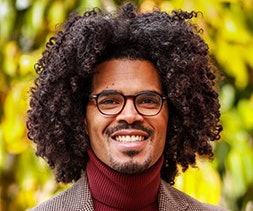Does the higher education world still need to talk about campus climate with campuses shut down? Student advocates say yes.
On Friday, Diverse hosted an online discussion titled “Calling Out Xenophobia, Racism and Intolerance During the COVID-19 Crisis,” moderated by editor-at-large Dr. Jamal Watson. As campus resources and classes moved online, so did harmful biases, panelists noted, calling for fresh approaches from colleges and universities.
“This is a moment to strengthen our solidarity in and across racial groups,” said Dr. Charles H.F. Davis III, assistant professor of clinical education at the University of Southern California. “This is an opportunity to forge together even stronger as a community to fight the rising tide of White supremacy on campus.”
 Dr. Charles H.F. Davis III
Dr. Charles H.F. Davis IIISpeakers emphasized the need to address Zoombombing, where users bombard remote classes with racist messages. Asian students in particular have been targeted for online harassment, Davis said.
He advised universities to create protocols for faculty to respond to these incidents so they’re not caught off guard, and in turn, encouraged faculty to take all the necessary steps to prevent them from happening – password protecting Zoom classes, having a co-host monitor chat discussions and removing the screen sharing feature.
Beyond that, faculty need to establish clear policies about speech in the virtual classroom, outlined in their syllabi, while keeping an eye out for “subtler forms” of discrimination like “cyberbullying and exclusion,” said Dr. Leandra Parris, assistant professor of school psychology at the College of William & Mary.
But panelists argued that promoting equity during the coronavirus isn’t just about calling out new forms of racism in the classroom but also acknowledging the disparate effects of the pandemic on underprivileged students.
 Dr. Leandra Parris
Dr. Leandra ParrisThe coronavirus is disproportionately impacting communities of color, Davis noted. Meanwhile, minority students are more likely to live in multi-generational homes where they might have extra household responsibilities like caring for siblings in addition to their school work. So, among other things, he suggested flexibility in grading practices and conscious “Zoom etiquette,” like letting students avoid using video if they don’t want to show their surroundings.
“Of course all students have been affected to some extent,” he said. “We know coronavirus doesn’t discriminate, but we do know that policies and practices in higher education do.”
In online education, Dr. Vanessa Sansone, assistant professor of higher education at the University of Texas at San Antonio, encouraged university leaders to think about the interplay – and the compounded effects – of race and class, based on her work on students of color in rural areas.
“There’s a lot of putting students in boxes,” she said. “In reality, we’re all multiple things.”
Ultimately, panelists’ worries about equity extended beyond the spring semester to what happens when students return to campus.
 Dr. Vanessa Sansone
Dr. Vanessa SansoneThey particularly fear that universities may divert funds from diversity, equity and inclusion resources on campuses in response to the crisis, even though diversity professionals and ethnic studies scholars are uniquely equipped to address the needs of underrepresented students in the aftermath.
“Whenever there’s anything else to prioritize, diversity and equity get cut,” Parris said.
But with enrollment rates threatening to drop, it’s in colleges’ interest to prioritize the needs of minority students as the demographics of the country change, explained Sansone.
“Students are hurting right now and they want to know they’re going to go to institutions that care about them holistically,” Sansone said. “… If you want to keep your enrollment up and fill seats, these are the populations you’re going to have to consider and be creative and intentional and thoughtful about in terms of how you respond.”
While the coronavirus poses new threats to diversity, equity and inclusion in higher education, panelists also described this moment as an opportunity to initiate lasting changes, particularly to admissions and financial aid.
For example, Davis pointed out that universities are adopting temporary test optional policies in response to the pandemic.
He hopes this move will prompt consideration of a “deeper question about why we’re so committed and invested in a thing that’s actually stratifying us further and introducing greater inequities,” he said. “We have to have an honest conversation about why we continue to do things as usual when we could actually radically reimagine a different university.”
Watch the webinar here.
Sara Weissman can be reached at [email protected].
Editor’s Note: On April 22 at 1 pm EDT, Diverse Hiring presents ‘What You Can Do to Recruit and Retain Diverse Faculty and Staff During COVID-19.’ Click here to register for this free webcast. Space is limited.


















